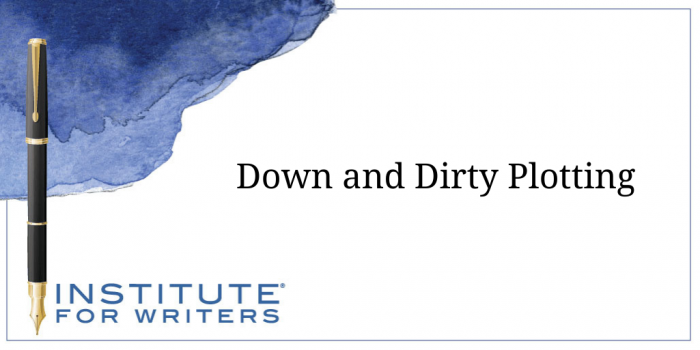1000 N. West Street #1200, Wilmington, DE 19801
© 2024 Direct Learning Systems, Inc. All rights reserved.
Beginning Tuesday, July 22, 2025 at 10 PM CT through Wednesday, July 23, 2025 at 4 AM CT, we will be performing scheduled maintenance to update our website.

We teach our students how to write and get published!
View our Course Catalog >
With National Novel Writing Month (NaNoWriMo) right around the corner, or if you’re about to write a new book, it’s helpful to have a plot outline in front of you when you’re stuck as to what to write next.
There’s plenty of tips and techniques for plotting. Some people like to plot in groups with their friends. Some would rather work it out all by themselves. Others use a big tri-fold craft board and put colored coated sticky notes all over it. While still others have it written or typed up, chapter by chapter.
I’m all about quick and easy. In my process, I don’t want to waste any time not writing. When I’m not writing I’ve got my whole day to think about scenes and characters and how it all fits together. When I’m plotting, I pick and choose from various techniques.
Three-Act Structure
The three-act structure is a good place to start because it divides your book into three sections: the beginning, the middle, and the end—or act one, act two, and act three. In act one, you are going to introduce the characters and have one major plot point happen. In act two, you’re going to work on the characters’ story arcs and how they are growing from their experiences. There should be another plot point at the midpoint and then the midpoint reversal. The midpoint, in addition to being the middle of your novel should be the high point of the story so far. Yes, there will be ups and downs all along. But at the midpoint, things should be going well for your character. Then there’s the midpoint reversal, where, you guessed it, everything falls apart. In the third act, there is the black moment when all hope is lost and then the resolution and the closing.
Using this method, you know your beginning, middle, and end, and roughly what’s going to happen in the book. You also know when it crashes and burns, and how to fix it to get a satisfying ending. Generally, that’s all I need to start working on my book. However, if you like to have more information before you put pen to paper, professional screenwriter Blake Snyder has more points you can add in each act in his book, Save the Cat.
The W Plot
Similar to the three-act structure, the W plot method works with plot points. Picture a capital “W.” At the top of the “W” is the inciting incident, that triggers your story in motion. Then, you slide down the “W” writing your beginning and that first low point you get to is your first turning point. Then you have rising action up to the top of the “W,” and you are now at the midpoint where there should be another “triggering” event that sets the plot in motion for another downward slide to the second turning point, which is the dark moment. Then, you complete the “W” by drawing up all the resolution until you end on top. In this method, you only need to know five plot points: the triggering event that incites your story, the first turning point, a second triggering event, the dark moment and the ending. This plotting method is based on Hollywood producer, Kenneth Atchity’s book, Write Time.
The Snowflake Method
I think this method should be called the snowball method because you start small and then gradually get bigger, like rolling a snowball through the snow. You start off with a one-sentence description of your story, then you build it into a paragraph. Then you build that paragraph to one page by writing what happens in the book: the inciting incident, the major plot points, the black moment, and the ending. So, it’s like first you write the elevator pitch, then you write the query. From there, it goes on that you write pages about the characters, and then expand the one-page synopsis to four pages. And it goes on. This is so not my process, I want to run screaming from the avalanche of information that built from the snowflake. But this technique might work for you, so I put a link to a more detailed version at the end of this blog post.
No matter what you decide to do when you plot, eventually you’ll have:
1. Inciting/triggering incident
2. First turning point
3. Second triggering incident/midpoint
4. Second turning point / midpoint reversal
5. Dark moment / Black moment
6. Ending / Resolution
Once you have these six things, you are ready to write a first draft. Keep in mind that plot points are fluid and will probably change as the actual scenes develop. Good luck!
1000 N. West Street #1200, Wilmington, DE 19801
© 2024 Direct Learning Systems, Inc. All rights reserved.
1000 N. West Street #1200, Wilmington, DE 19801
© 2024 Direct Learning Systems, Inc. All rights reserved.
1000 N. West Street #1200, Wilmington, DE 19801
© 2024 Direct Learning Systems, Inc. All rights reserved.
1000 N. West Street #1200, Wilmington, DE 19801
© 2025 Direct Learning Systems, Inc. All rights reserved.
1000 N. West Street #1200, Wilmington, DE 19801
©2025 Direct Learning Systems, Inc. All rights reserved. Privacy Policy.